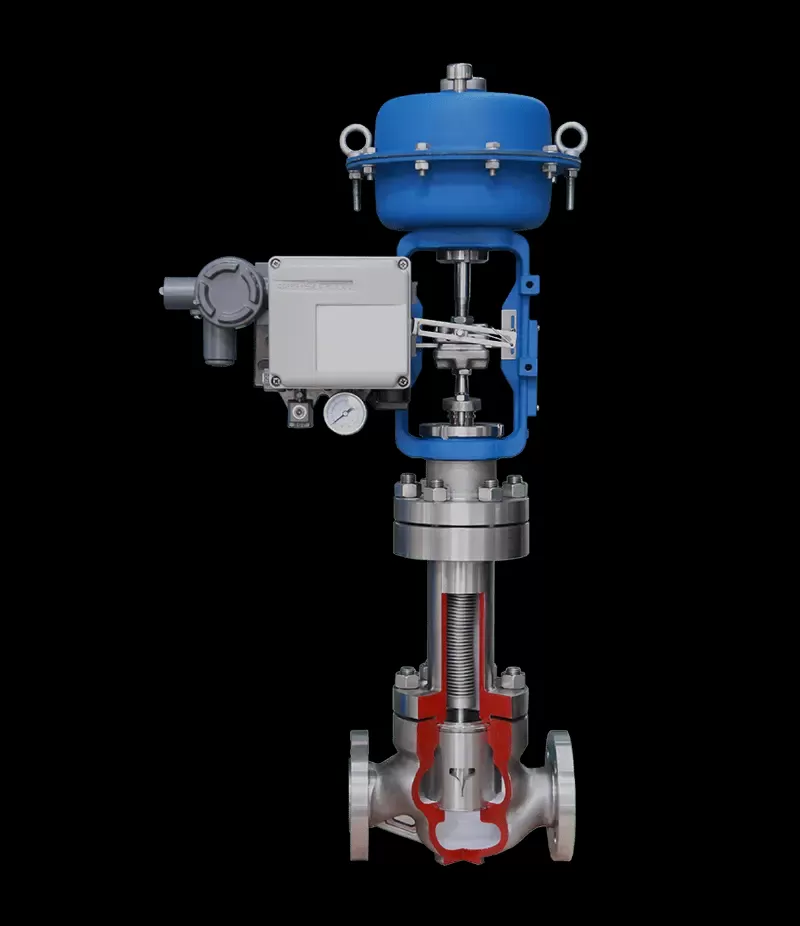Notifications
8 minutes, 9 seconds
-4 Views 0 Comments 0 Likes 0 Reviews

Introduction
As a leading control valve manufacturer in China, we deliver high-quality valves and control actuators expertly designed to meet a wide range of industrial applications.
In industries where safety, environmental protection, and process reliability are critical, even the smallest leaks can have severe consequences. Whether in petrochemical plants, pharmaceutical production, power generation, or semiconductor manufacturing, strict adherence to safety and emission standards is essential. In these demanding environments, bellows globe control valves have emerged as vital components for precision control and zero-emission performance.
A bellows globe control valve is a specialized type of globe valve distinguished by its integrated bellows seal—a flexible metallic component that ensures a hermetic seal around the valve stem. This design prevents fugitive emissions, improves sealing integrity, and enhances the valve’s ability to handle hazardous or volatile fluids safely. The bellows structure not only eliminates stem leakage but also extends operational life and reduces maintenance requirements.
This article delves into the design, features, benefits, applications, and technical details of bellows globe control valves, offering a comprehensive view of their role in safe and efficient industrial operations.
What is a Bellows Globe Control Valve?
A bellows globe control valve is a linear-motion valve used to precisely regulate fluid flow in pipeline systems. Unlike conventional globe valves, it incorporates a metallic bellows between the valve body and stem. This bellows expands and contracts as the stem moves, isolating the process fluid from the environment and eliminating the risk of leakage along the stem.
Typically made from corrosion-resistant stainless steel or high-performance alloys like Inconel, the bellows is welded securely to both the valve stem and bonnet. As the stem modulates flow, the bellows flexes to maintain a sealed barrier, ensuring zero leakage—even under high pressure, aggressive chemicals, or elevated temperatures.
Why Choose a Bellows Seal Design?
Traditional globe valves rely on packing around the stem to prevent leaks. However, packing materials wear out, degrade, or loosen over time—especially when exposed to thermal cycling, vibration, or corrosive fluids—leading to fugitive emissions.
Bellows-sealed globe valves eliminate this problem by replacing packing with a metallic bellows seal, offering significant advantages:
Hermetic sealing: Prevents emissions to the environment, meeting strict regulations such as TA-Luft, ISO 15848, and EPA standards.
Low maintenance: Removes the need for regular packing adjustments or replacements, lowering maintenance costs and downtime.
Extended service life: Bellows are engineered for tens of thousands of full-stroke cycles, providing durability and reliability.
Enhanced safety: Critical for handling hazardous, toxic, or flammable fluids where leakage risks must be minimized.
Key Design Features of Bellows Globe Control Valves
Metallic Bellows Assembly:
Constructed from thin-walled stainless steel or Inconel, designed for flexibility and durability. Each bellows is helium leak-tested to ensure absolute sealing integrity.
Non-Rotating Stem:
Prevents torsional stress on the bellows, improving stability and alignment during operation.
Hermetically Welded Connections:
Minimizes threaded or flanged joints in critical sealing areas by using welded joints, eliminating potential leak paths.
Vacuum Brazed or Welded Seat:
Permanently joins the valve seat to the body, preventing loosening and leaks common with traditional threaded seats.
Back-Up Packing Seal:
Provides a secondary seal in case of bellows failure. Some models include a leak detection port between the bellows and packing for early warning.
How Does the Globe Control Valve Work?
Globe valves get their name from their spherical body shape surrounding the valve seat. They control flow by moving a plug or disc linearly against a fixed seat, allowing precise throttling.
Main components include:
Valve Body: Pressure-retaining shell with inlet and outlet ports.
Bonnet: Houses the stem and bellows assembly.
Valve Stem: Connects to the actuator or handwheel to transfer motion.
Plug (Disc): The flow-control element that adjusts or stops fluid flow.
Seat Ring: Provides a sealing surface for the plug.
Bellows Seal: Welded to stem and bonnet to prevent leakage along the stem.
Packing and Gland Assembly: Secondary seal for backup.
Globe valves are often automated using pneumatic, electric, or hydraulic actuators for remote or precise control.
Internal Trim and Flow Characteristics
The internal trim—especially cage-type designs—greatly influences valve performance:
Cage Guidance: Keeps the plug centered for smooth operation.
Replaceable Trim: Enables flow characteristic adjustments or upgrades (e.g., noise reduction).
Anti-Cavitation Features: Minimize cavitation damage in high differential pressure scenarios.
Noise Control Options: Reduce noise levels in gas or steam service.
This combination of bellows sealing and advanced trim design yields highly accurate flow control, longer valve life, and enhanced safety.
Advantages and Benefits
Zero Leakage Guarantee:
Helium leak tests ensure leakage rates as low as 10⁻⁶ mbar·l/s, eliminating fugitive emissions.
Regulatory Compliance:
Meets stringent emission control standards, protecting personnel and the environment.
Reduced Maintenance:
No frequent repacking needed, lowering labor and spare part costs.
Long-Term Durability:
Bellows last 20,000 to 50,000 full stroke cycles and resist corrosion and fatigue.
Superior Process Control:
Provides precise, repeatable throttling with low hysteresis and quick response.
Versatile Applications:
Suitable for liquids, gases, vapors, and slurries across wide pressure and temperature ranges.
Common Applications
Petrochemical and Chemical Plants: Handling corrosive, flammable, or toxic fluids.
Power Generation: Boiler feedwater and high-pressure steam control.
Pharmaceutical and Food Industries: Sterile and cleanroom fluid control.
Semiconductor Manufacturing: Ultra-pure water and gas, vacuum processes.
Nuclear Facilities: Reactor coolant and containment systems.
Cryogenic Systems: Control of liquid oxygen, nitrogen, helium, and other cryogens.
Conclusion
In today’s industrial landscape, where safety, environmental compliance, and process reliability are non-negotiable, bellows globe control valves provide a superior solution. By integrating a metallic bellows seal with precision internal components, these valves ensure leak-free, low-maintenance, and highly accurate flow control.
Their robust design and long service life make them indispensable in applications involving hazardous or environmentally sensitive fluids. Whether in chemical plants, nuclear power stations, or cleanroom environments, bellows globe control valves deliver reliable performance and peace of mind in critical operations.Know more about Google SEO Directory
Wheel Excavator Manufacturer China Excavator Manufacturer China Wheeled Excavators

